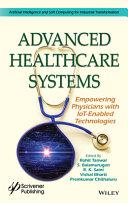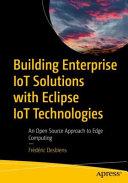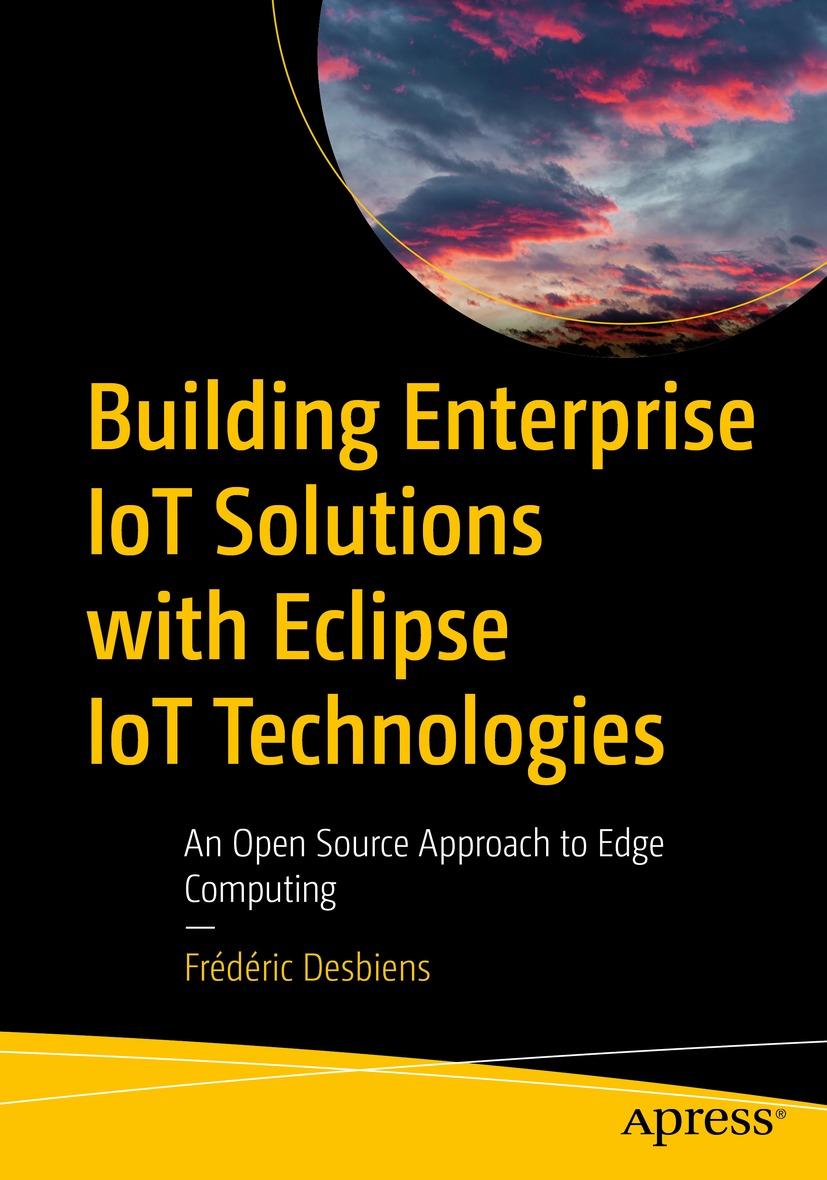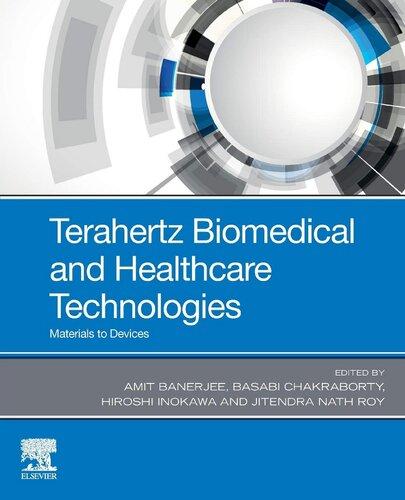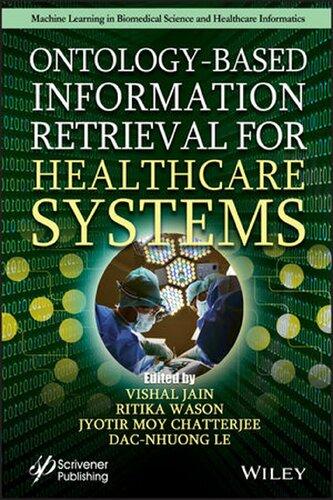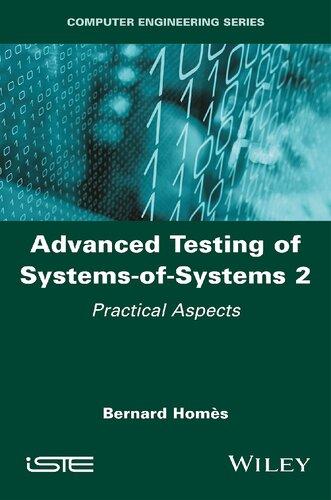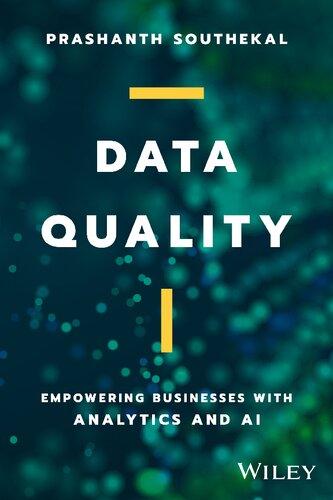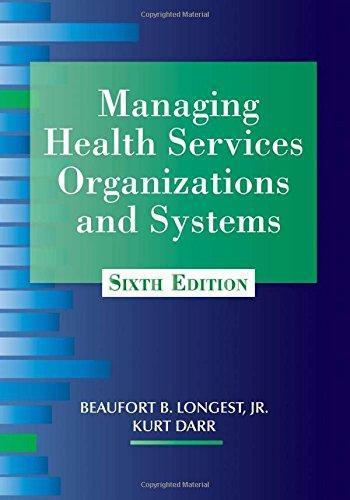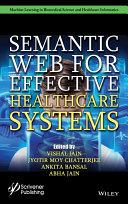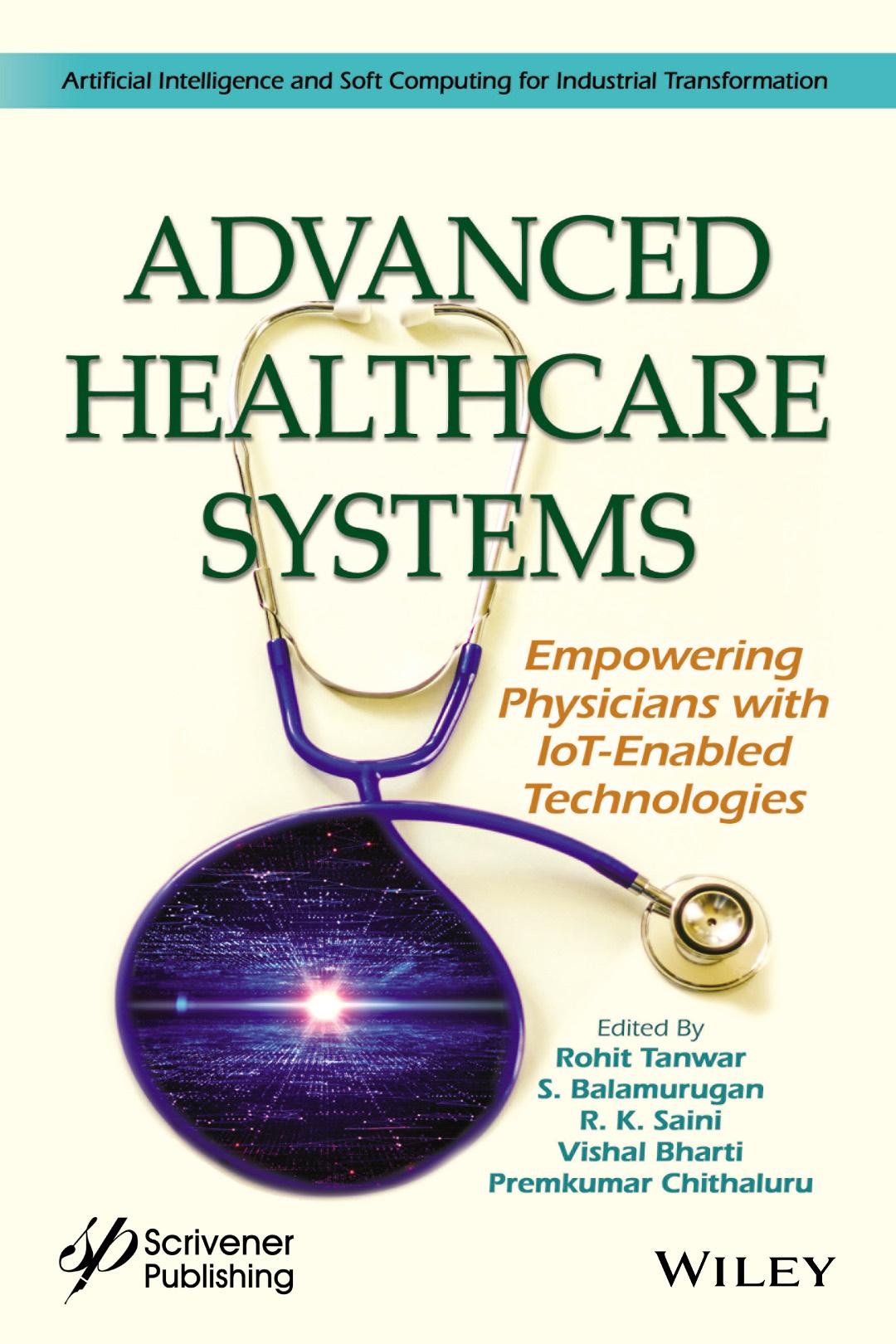Advanced Healthcare Systems
Scrivener Publishing
100 Cummings Center, Suite 541J Beverly, MA 01915-6106
Artificial Intelligence and So Computing for Industrial Transformation
Series Editor: Dr. S. Balamurugan (sbnbala@gmail.com)
Scope: Artificial Intelligence and So Computing Techniques play an impeccable role in industrial transformation. e topics to be covered in this book series include Arti cial Intelligence, Machine Learning, Deep Learning, Neural Networks, Fuzzy Logic, Genetic Algorithms, Particle Swarm Optimization, Evolutionary Algorithms, Nature Inspired Algorithms, Simulated Annealing, Metaheuristics, Cuckoo Search, Fire y Optimization, Bio-inspired Algorithms, Ant Colony Optimization, Heuristic Search Techniques, Reinforcement Learning, Inductive Learning, Statistical Learning, Supervised and Unsupervised Learning, Association Learning and Clustering, Reasoning, Support Vector Machine, Di erential Evolution Algorithms, Expert Systems, Neuro Fuzzy Hybrid Systems, Genetic Neuro Hybrid Systems, Genetic Fuzzy Hybrid Systems and other Hybridized So Computing Techniques and their applications for Industrial Transformation. e book series is aimed to provide comprehensive handbooks and reference books for the bene t of scientists, research scholars, students and industry professional working towards next generation industrial transformation.
Publishers at Scrivener
Martin Scrivener (martin@scrivenerpublishing.com)
Phillip Carmical (pcarmical@scrivenerpublishing.com)
Advanced Healthcare Systems
Empowering Physicians with IoT-Enabled Technologies
Edited by Rohit Tanwar, S. Balamurugan, R. K. Saini, Vishal Bharti and Premkumar Chithaluru
This edition first published 2022 by John Wiley & Sons, Inc., 111 River Street, Hoboken, NJ 07030, USA and Scrivener Publishing LLC, 100 Cummings Center, Suite 541J, Beverly, MA 01915, USA © 2022 Scrivener Publishing LLC
For more information about Scrivener publications please visit www.scrivenerpublishing.com.
All rights reserved. No part of this publication may be reproduced, stored in a retrieval system, or transmitted, in any form or by any means, electronic, mechanical, photocopying, recording, or otherwise, except as permitted by law. Advice on how to obtain permission to reuse material from this title is available at http://www.wiley.com/go/permissions.
Wiley Global Headquarters
111 River Street, Hoboken, NJ 07030, USA
For details of our global editorial offices, customer services, and more information about Wiley products visit us at www.wiley.com.
Limit of Liability/Disclaimer of Warranty
While the publisher and authors have used their best efforts in preparing this work, they make no representations or warranties with respect to the accuracy or completeness of the contents of this work and specifically disclaim all warranties, including without limitation any implied warranties of merchantability or fitness for a particular purpose. No warranty may be created or extended by sales representatives, written sales materials, or promotional statements for this work. The fact that an organization, website, or product is referred to in this work as a citation and/or potential source of further information does not mean that the publisher and authors endorse the information or services the organization, website, or product may provide or recommendations it may make. This work is sold with the understanding that the publisher is not engaged in rendering professional services. The advice and strategies contained herein may not be suitable for your situation. You should consult with a specialist where appropriate. Neither the publisher nor authors shall be liable for any loss of profit or any other commercial damages, including but not limited to special, incidental, consequential, or other damages. Further, readers should be aware that websites listed in this work may have changed or disappeared between when this work was written and when it is read.
Library of Congress Cataloging-in-Publication Data
ISBN 978-1-119-76886-9
Cover image: Pixabay.Com
Cover design by Russell Richardson
Set in size of 11pt and Minion Pro by Manila Typesetting Company, Makati, Philippines
9.4.4.5
9.4.4.6
V. Lakshman Narayana, R. S. M. Lakshmi Patibandla, B. Tarakeswara Rao and Arepalli Peda Gopi
Preface
The applications and challenges of machine learning and artificial intelligence in the internet of things for healthcare applications are comprehensively covered in this book. Rapid developments in hardware, software and communication technologies have facilitated the emergence of internet-connected sensory devices that provide observations and data measurements from the physical world. The technology of internet-connected devices, referred to as the internet of things (IoT), continues to extend the current internet by providing connectivity and interactions between the physical and cyber worlds. The IoT is undoubtedly transforming the healthcare industry by redefining the space of devices and interaction of people in delivering healthcare solutions, resulting in applications that benefit patients, families, physicians, hospitals and insurance companies. The use of remote monitoring in the healthcare sector possible with IoT-enabled devices has the potential to keep patients safe and healthy, and empowers doctors to provide superlative care, thereby increasing patients’ engagement and satisfaction as a result of their interactions with doctors becoming easier and more efficient. Furthermore, remote monitoring of patients’ health helps reduce the length of hospital stays and prevents readmissions, in addition to having a major impact on reducing healthcare costs significantly and improving treatment outcomes.
In addition to increasing volume, the IoT generates big data characterized by its velocity in terms of time and location dependency, with a variety of multiple modalities and varying data quality. Intelligent processing and analysis of this big data are the keys to developing smart IoT applications, thereby making space for machine learning (ML) applications. Due to its computational tools that can substitute for human intelligence in the performance of certain tasks, artificial intelligence (AI) makes it possible for machines to learn from experience, adjust to new inputs and perform human-like tasks. Since IoT platforms provide an interface to gather the data from various devices, they can easily be deployed into AI/ML systems. The value of AI in this context is its ability to quickly mesh insights from data and automatically
identify patterns and detect anomalies in the data that smart sensors and devices generate — information such as temperature, pressure, humidity, air quality, vibration and sound — that can be really helpful.
Our intent in publishing this book was to comprehensively discuss all of the applications and challenges of using ML and AI in the IoT for healthcare applications that will benefit research scholars working in this domain. Therefore, the 17 chapters of the book briefly discussed below present IoT concepts, frameworks and ideas on biomedical data analytics and information retrieval from the different biomedical domains. The editorial advisory board and expert reviewers have ensured the high caliber of the chapters through careful refereeing of the submitted papers. For the purpose of coherence, we have organized the chapters with respect to similarity of topics addressed, ranging from issues pertaining to the IoT for biomedical engineering and health informatics to computational intelligence for medical image processing and biomedical natural language processing.
• In Chapter 1, “Internet of Medical Things – State of the Art,” Dr. Kishor Joshi and Dr. Ruchi Mehrotra present the latest technological advancements in the on-body segment of consumer health wearables. Since the traditional approach in healthcare is a more personalized touch-based system, it is not replaceable for diagnosis. Older, chronically ill patients need remote monitoring and medial management services that ensure that nurses or local healthcare assistants connect to doctors in urban or super-specialty fields for better services. This chapter indicates there is already a steep rise in internet of medical things (IoMT) products, but there is still huge potential for growth in the IoMT industry.
• In Chapter 2, “Issues and Challenges Related to Privacy and Security in Healthcare Using IoT, Fog and Cloud Computing” Hritu Raj, Mohit Kumar, Prashant Kumar, Amritpal Singh and Om Prakash Verma describe the complete architecture along with various challenges and security risks of the next generation healthcare industry with healthcare IoT sensor and fog computing. Furthermore, some methodologies used in various research papers are presented that address security and privacy-related issues in the IoT, Fog and Cloud computing environment.
• In Chapter 3, “Study of Thyroid Disease Diagnosis Using Machine Learning Technique,” Shanu Verma, Dr. Rashmi Popli and Dr. Harish Kumar discuss Graves’ disease, the
most common cause of hypothyroidism that is associated with eye disease. Thyroid cancer, which infects the gland at the base of the neck, has been increasing over the past few years. Endocrinologists believe that this is because the use of new technology, i.e., machine learning, has allowed the detection of thyroid cancer that may not have been detected in the past. According to the Cancer Registry, thyroid cancer is the second more common cancer among women, occurring 3 times more often in women than in men. This chapter studies thyroid disease using a machine learning algorithm.
• In Chapter 4, “A Review of Various Security and Privacy Innovations for IoT Applications in Healthcare,” Mr. Abhishek Raghuvanshi, Dr. Umesh Kumar Singh and Mr. Chirag Joshi focus on the analysis of numerous security and privacy technologies in healthcare, intelligent communities and smart homes available for IoT applications. According to the findings of an industrial internet survey by the World Economic Forum, roughly two-thirds of respondents said the main issue was interoperability and protection. Most IoT apps are web applications and all of them still have denial-of-service and man-in-the-middle attacks as major threats to the security of their healthcare, smart city, smart home and other IoT applications.
• In Chapter 5, “Methods of Lung Segmentation Based on CT Images,” Amit Verma and Thipendra P. Singh focus on the use of CT scan images for analysis of lung airways, lung parenchyma, and breathing mechanisms. For better diagnosis of any lung problems, the automatic, nearly accurate analysis of CT images is better than the manual method of doctors analyzing CT scans. In this chapter, automatic and semi-automatic methods of segmentation of lung CT images are discussed.
• In Chapter 6, “Handling Unbalanced Data in Clinical Images,” Amit Verma focuses on various data-level and algorithm-level-based approaches developed to balance imbalanced data for improving the accuracy of the trained model. In this chapter, the concept and problem of imbalanced data is discussed and various approaches for balancing the data are also highlighted, in which one of the state-ofthe-art methods called bagging is discussed in detail.
• In Chapter 7, “IoT-Based Health Monitoring System for Speech Impaired People Using Assistive Wearable Accelerometer,” Dr. Madhumathy P., Ishita Banerjee and Digvijay Pandey describe IoT-based wireless communication systems with network devices connected to each other that communicate through open source internet access and establish connection between apps and devices for communication between the person being supervised and the medical supervisor. This system can also keep track of real-time records and emergency alerts. To handle the storage and analysis of data-related issues, IoT analytics is implemented.
• In Chapter 8, “Smart IoT Devices for the Elderly and People with Disabilities,” K. N. D. Saile and Kolisetti Navatha focus on the huge changes brought about by the IoT-powered revolution in health management devices for the elderly and disabled like sensors, wearable devices, audio and video assistance, etc. All these are possible with the help of the IoT. In this chapter, we discuss the technology trends in devices made during the IoT era.
• In Chapter 9, “IoT-Based Health Monitoring and Tracking System for Soldiers,” Dr. Madhumathy P., Kavitha N and Digvijay Pandey discuss smart sensors used in the medical treatment of soldiers. By tracking a soldier’s location on the battlefield with a smart sensor attached to their body, more accurate body status information can be provided to medical units in order to offer more immediate care. These systems are designed to be implemented for complete mobility with a personal server, which in turn would give a message to the server base station through wireless mode. Soldiers are able to be identified at the earliest based on their unique IP address.
• In Chapter 10, “Cloud-IoT Secured Prediction System for Processing and Analysis of Healthcare Data Using Machine Learning Techniques,” Dr. G. K. Kamalam, and Ms. S. Anitha discuss a cloud-IoT secured prediction system designed to improve healthcare performance by reducing the execution time of a patient’s request, optimizing the desired selection of the massive amount of patient’s facts and imparting a records retrieval process for those applications. Analysis of the experimental results show that the presented method performs better than existing benchmark systems
for considering parameters like disease prediction accuracy, sensitivity, specificity, F-measure, and computational time.
• In Chapter 11, “Cloud-IoT-Driven Healthcare: Review, Architecture, Security Implications and Open Research Issues,” Junaid Latief Shah, Heena Farooq Bhat and Asif Iqbal Khan discuss security loopholes inherent in IoT architecture and the Cloud platform. The chapter also elaborates on various security countermeasures that have been proposed in the literature, highlighting their strengths and limitations. Also, a discussion on possible defense measures has been provided. The chapter culminates in underlining some burning research problems and security issues that need to be addressed for seamless healthcare services.
• In Chapter 12, “A Novel Usage of Artificial Intelligence and Internet of Things in Remote-Based Healthcare Applications,” Dr. V. Arulkumar, D. Mansoor Hussain, S. Sridhar, and Dr. P. Vivekananda present the information necessary to reap the benefits of research capacity solutions through AI techniques. Healthcare services are among the applications enabled by the IoT. Advanced sensors may be used to monitor the health of permanent patients or may be inserted into the bodies of patients that can analyze, combine and prioritize the information gathered. Working with algorithms helps doctors change treatments and, at the same time, helps to economize on healthcare.
• In Chapter 13, “Use of Machine Learning in Healthcare,” V. Lakshman Narayana, R. S. M. Lakshmi Patibandla, B. Tarakeswara Rao and Arepalli Peda Gopi focus on AI-assisted healthcare. Quotient Health has developed a program designed to reduce the cost of EMR structures by strengthening and standardizing the structuring of these frames. This chapter discusses healthcare AI, various implementations of AI, certifiable healthcare benefits, the morality of AI computations and opportunities to improve quality of healthcare skills.
• In Chapter 14, “Methods of MRI Brain Tumor Segmentation,” Amit Verma discusses the requirements for and importance of using MRI imaging in brain tumor segmentation and the basic methods of doing it. Furthermore, a region-based generative model with weighted aggregation methods for
performing brain tumor segmentation using MRI images is also discussed.
• In Chapter 15, “Early Detection of Type 2 Diabetes Mellitus Using a Deep Neural Network-Based Model,” Varun Sapra and Luxmi Sapra focus on implementing a deep neural network for early identification of diabetes mellitus. For this purpose, benchmark dataset available on the UCI Machine Learning Repository and Kaggle are explored. This chapter suggests a deep neural network-based framework for early detection of disease that can be used as an adjunct tool in clinical practices.
• In Chapter 16, “A Comparative Analysis of Implementation Framework for Masked Face Detection,” Pranjali Singh, Amitesh Garg and Amritpal Singh discuss quick and accurate approaches for the difficult task of face recognition resulting from certain facial features being hidden by the masks used during the current pandemic. This study uses deep learningrelated techniques to resolve the issues of detecting facial features hidden by a mask. Another method of face mask detection is through TensorFlow, YOLOv5, SSDMNV2, SVMs, OpenCV, and Keras. The first step is to discard the masked face region. Next, a pre-trained deep convolutional neural network (CNN) is applied to extract the best features from the obtained regions. Labeled image data is used to train the CNN model. With 98.7% accuracy, a face mask is identified by the proposed system. By using the SVM classifier, the dataset of RMFD had a testing accuracy of 99.64%, SMFD achieved a 99.49% testing accuracy, and LFW achieved 100% testing accuracy. The SSDMNV2 approach used in the study in this chapter yields a 92.64% accuracy score and a 93% F1 score.
• In Chapter 17, “IoT-Based Automated Healthcare System,” Dr. Darpan Anand and Mr. Ashish Kumar give an overview of the SDN and NFV types of sensors used in IoT devices. Apart from that, the views of various researchers are also given. The challenges of an SDN-based IoT device for healthcare architecture are also discussed.
The seventeen chapters of this book were written by eminent professors, researchers, and those in the industry from different countries. The chapters were initially peer reviewed by the editorial board members, reviewers, and those in the industry who also span many countries. All chapters
Preface xxiii
have been designed to include basic introductory topics and advancements as well as future research directions, which will enable budding researchers and engineers to pursue their work in this area.
The topic of intelligent IoT for advanced healthcare system(s) is so diversified that it cannot be covered in a single book. However, with the encouraging research contributed by the researchers in this book, we (contributors), editorial board members, and reviewers tried to sum up the latest research domains, developments in the data analytics field, and other applicable areas. First and foremost, we express our heartfelt appreciation to all the authors. We thank them all for considering and trusting this edited book as the platform for publishing their valuable work, and for for the kind co-operation extended by them during the various stages of processing this manuscript. We hope this book will serve as a motivating factor for those researchers who have spent years working as crime analysts, data analysts, statisticians, and budding researchers.
Dr. Rohit Tanwar School of Computer Science, University of Petroleum and Energy Studies, Dehradun, India
Dr. S. Balamurugan Director of Research and Development, Intelligent Research Consultancy Service (iRCS), Coimbatore, India
Dr. Rakesh Kumai Saini School of Computing, DIT University, Dehradun, India
Dr. Vishal Bharti School of Computing, DIT University, Dehradun, India
Dr. Premkumar Chithaluru School of Computer Science, University of Petroleum and Energy Studies, Dehradun, India
1 Internet of Medical Things— State-of-the-Art
Kishor Joshi1 and Ruchi Mehrotra2*
1Mahavir Heart Hospital, Patna, India
2University of Petroleum & Energy Studies, Dehradun, India
Abstract
Technological innovations have helped in early diagnosis and disease management, thereby preventing long-term complications of various diseases which contribute to morbidity and mortality. Internet of Things used in the healthcare industry and is the Internet of Medical Things (IoMT). The chapter compiles seminal research about IoMT. The paper elaborates the growth of the IoMT market in the last decade from in-hospital and clinics and having reached to home segment as well. With every second, 127 IoT devices adding in the market, and by 2021, it is expected that 35 billion devices will be connected to web, and by 2026, this market will touch almost one trillion US dollars. There are virtual clinics and telehealth for remote monitoring of patients both in rural areas and even where immediate access to clinicians by severely sick patients is always needed like cardiac and obstetric care. There is personal emergency response system (PERS) becoming highly popular in case of chronic critical diseases and is life-saving. The paper covers latest technological advancements for the on-body segment like the consumer health wearables. The traditional approach in healthcare being more personalized and touch-based system is not replaceable for diagnosis. The old-age, chronically ill patients need remote monitoring and medial management services that ensure the nurses or local healthcare assistants connect to doctors in urban or superspeciality fields for better services. The conclusion indicates that there is already a steep rise in IoMT products, but there is still a huge potential for growth in the IoMT industry.
Keywords: Technology, innovations, healthcare, mortality, diagnosis
*Corresponding author: uniqueruchi@rediffmail.com
Rohit Tanwar, S. Balamurugan, R. K. Saini, Vishal Bharti and Premkumar Chithaluru (eds.) Advanced Healthcare Systems: Empowering Physicians with IoT-Enabled Technologies, (1–20) © 2022 Scrivener Publishing LLC
1.1 Introduction
Early diagnosis and timely management of diseases through technological interventions prevents long-term complications and mortalities. The critical diseases like heart disease and stroke are leading cause of various forms of disability and death across the world. The burden of disease is extremely high in both developed and developing countries and least developed countries (LDCs). One of the main difference lies is with technology embedded systems and usage of Internet of Things (IoT) in entire medical treatment plans and even used later for monitoring of patients. This incredible change in the medical industry has been established with application of technology and specifically IoT in healthcare. IoT is defined as “Sensors and actuators embedded in physical objects are linked through the wired and wireless networks” [1]. Infrastructure facilities, optimal resource utilization, quality of service delivery, regular monitoring, timeliness of reporting, and resource mobilization have strengthened healthcare systems. It is more interactive and quick responsive system which is necessary for medical services.
1.2 Historical Evolution of IoT to IoMT
Kevin Ashton who worked for Procter & Gamble in the year 1999 attempted to invent new technology to apply in his work space which led to the idea of linking radio-frequency identification (RFID) to “IoT”. Hence, this game changer technology was also known as embedded internet or pervasive computing. The year 2000 marked the beginning of internet in industries and almost all enterprises for information storage and retrieval of data. However, the accuracy being a concern so human to things and things to things interaction became more popular gradually. So, this slow development until 2010 suddenly saw a boom after the Gartner report in 2011. According to them, IoT is the network of physical objects which comprise of embedded technology for communication and interact with their internal states or the external environment [2]. IoT has helped in generation and utilization of huge data for rapid data processing. IoT utilizes cloud computing–enabled applications like consumer file storage. For leading company, Compaq, it was start of annually 2 billion USD turnover to sell servers to internet providers [3].
Though few aspects are non-replaceable by any form technology, still, digital interventions have penetrated in almost every component of all industries. Like in cases of libraries where, conventionally, these are in physical form of services and infrastructure, but it is now replaced with digital data storage and sharing to remotely access the intellectual content by anyone, anytime [4].
Healthcare has been traditionally more popular in its physical form of interaction between patient and nurses, pathologist, pharmacist, or clinicians. Hence, the emerging technology is transforming lives by replacing the human touch in partial mode in banking and financial markets, retail shopping, education, security systems, and many other sectors. Healthcare sector has seen massive change by reducing the number of visits to the hospital due to technological developments [5, 6]. In true sense, the leverage for power of IoT is to eliminate the burden of healthcare sector by enabling patients to connect with the medical facility providers by transferring their data in a secured embedded system.
The internet has been rebranded and is now referred to as “the cloud”. The IoT device requires a unique identification enabled by the RFID. Device has sensors for monitoring various parameters and can send the data through a wired or wireless communication to the cloud where this data is stored and can be converted into information. The procession of the enormous amount of data continuously generated (Big Data) requires immense computing power which is available in the cloud servers.
Now, with technological advancements, the medical devices are enabled to collect, analyze, and send data across the web using these advancements. They can now connect both digital and non-digital heart monitor like the heart monitor with patient beds directly to internet. Internet of Medical Things (IoMT) is going to bring a paradigm shift and will alter the future of healthcare by providing smart digital solutions with ease, comfort, availability, and accessibility of quality healthcare anywhere, anytime.
Most of the healthcare professionals and hospitals are now using IoT devices to optimally use their resources. Almost 70% of such hospitals and organizations use patient monitoring and maintenance of patient records. Patient data record is to be kept safely but industry is not tamper-proof, and hence, data leakage is still an issue in case of IoT. But still, in IoMT, there is an upper hand in as it has smart solutions which include endpoint security, internal segmentation, standard policies, and practices to authenticate end users and real-time monitoring which safety measures to prevent data breaches.
1.2.1 IoT and IoMT—Market Size
With half of the IoT market, IoMT constitutes the largest part IoT market. In 2017, IoT market was at $41 billion and expected to increase to $158 billion in 2022 with connected medical devices contributing to one-third of the market by 2022 [7]. The statistics indicate the gradual penetration of IoT technology. Almost 7 billion IoT devices were there in 2018, and in 2019, it jumped to 26.66 billion active IoT devices. Every second, 127 new IoT devices are connected to web, and by end of 2021, there will be almost 35 billion IoT devices installed worldwide. In terms of revenue generation for IoT market, the global spending on IoT in 2016 was $737 billion, and by 2021, it is expected to reach $124 billion, and only by 2026, it will reach $1.1 trillion. This indicates the enormity of IoT markets as global IoT healthcare market should reach 14 billion USD by 2024 [8].
Electronic patient records and patient monitoring are the largest usage of IoT in the present situation. Security in usage of IoMT is a major challenge. IoMT has improved the efficiency of healthcare delivery while lowering the cost of delivery per patient along with rapid implementation, thereby saving time and further lowering costs. The major challenge in IoMT is non-standardization of devices being in various platforms and inability for devices of one manufacturer to communicate with software or hardware of another. Multiple platform results in inefficiency. New devices and software need capital in terms of development and Food and Drug Administration (FDA) approval. Data privacy and security are factors that are to be kept in mind during its development and implementation. But implementation of IoMT increases cost of healthcare for devices, apps, cloud storage, and security. Data bandwidth required for the Big Data generated continuously by IoMT devices strains internet networks.
1.3 Smart Wearable Technology
The on-body segment or smart wearables can be broadly divided into consumer health wearables and medical- or clinical-grade wearables. Medicalgrade smart wearables are high quality and are FDA approved for use in hospital or home use. But recently, high-grade consumer wearables have taken on the quality of medical-grade wearables and have been validated in studies to be useful.
1.3.1 Consumer Fitness Smart Wearables
The most popular ones are wearable devices which are also called as lifestyle devices which include activity trackers like bands, wristwatches, chest strap,
and shoes. These devices are worn by patients as well as healthy people who are fitness conscious. Such devices have sensors that regularly monitor, record, and collect data based on the health parameters based on physical activities. Consumer smart wearables generate data which can help provide feedback to the individual regarding his/her health and thereby modify their lifestyle accordingly. But these devices are plagued with issues of reliability, safety, and security of this data [9]. A 2017 study by Apple and Standford University in 400,000 users of Apple watch series 1, 2, and 3 and its mobile app used data generated by the pulse sensors to identify hearth rhythm abnormality called atrial fibrillation. Atrial fibrillation is an irregularity of the heart beat with the pulse generated described as irregularly irregular. This can initially be intermittent with intervening normal heart rhythm or become chronic with continuous AF. The results of this study showed that 0.5% of the subjects received a notification of an irregular pulse. These subjects were sent a telemetry ECG patch to directly detect and monitor the electrical activity of the heart. Results showed that that the Apple watch diagnosed an episode of AF correctly 84% of the time and one-third were diagnosed with AF by the ECG patch. In addition, 57% of those who received an AF notification by the mobile app consulted a doctor. The Apple Heart Study shows that consumer wearable technology can help in detecting serious medical conditions like atrial fibrillation [10]. Consumer smart wearables can sense and continuously record some vital bodily functions and therefore provide feedback regarding health and help in modifying behaviour and lifestyle [11]. But more than half of the technology used in consumer smart wearables has not been certified or validated independently. Only 1 in 10 technologies has been validated with clinical research. Therefore, quality of data smart consumer wearables is debatable and interpretation of such data is questionable [12]. In contrast, clinical- or medical-grade wearables are approved or certified by health regulatory authorities like the FDA and are used with the advice of healthcare professionals or on prescription of a doctor. Accuracy of these devices can enable diagnosis and management of diseases.
1.3.2
Clinical-Grade Wearables
Medical-grade or clinical-grade wearables are those certified by the regulatory authorities like FDA for use by healthcare professionals. They can be used at home or in a clinic or hospital and expected to improve quality of life in chronic diseases and reduce the cost of long-term care.
With advances in technology, consumer wearables are slowly moving to the accuracy of medical-grade devices. A study by the Stanford University using the Apple watch with 4lac users showed that atrial fibrillation could
be detected in accurately to a high degree. The users were alerted about the arrhythmia by the smart watch and resulted in half of them consulting a doctor [13]. But this study was not ideal as it was not controlled and subjects were not randomized [14]. Increasing number of high quality Medical-grade wearables are slowly turning the focus of smart wearables from fitness and activity trackers to clinical-grade devices which can be used by medical professionals [15]. The Apple Watch 4 has a medical-grade sensor approved by the FDA [16].
Current Health (Edinburgh, Scotland) has created a wireless AI device for monitoring patients in hospital and also at home. This device monitors patient’s vital parameters like pulse rate, respiratory rate, oxygen saturation, temperature, and patient mobility. It provides doctors with continuous data regarding health of their patient in real time. Current Health uses machine learning for analysis of this data and generates useful information and detect any significant changes [17]. An insertable cardiac monitor named Confirm Rx developed by Abbott healthcare can monitor ECG continuously for up to 2 years and can connect to a smartphone app (myMerlin) wirelessly through Bluetooth. It can also automatically send information to the doctor who can correlate symptoms with the heart rhythm [18]. Wrist-worn wearable devices as developed by researchers at the University of Michigan can also can detect circulating cancer cells in the blood, thereby revolutionizing cancer care [19].
A wearable cardiac defibrillator (WCD) is a portable device which is worn on the body and can deliver life saving shocks to terminate lifethreatening ventricular arrhythmias. This can be used in lieu of an implantable cardioverter defibrillator (ICD) in patients who are not candidates for an ICD or early after a Myocardial infarction or are on the cardiac transplant list. In a study on uninsured patients with ischemic or nonischemic cardiomyopathy, WCD was shown to prevent unnecessary ICD implants in the subgroup of patients whose cardiac function subsequently improves following recovery thereby saving costs [20]. WCD can also be used in patients who are at high risk of ventricular arrhythmias and sudden cardiac death early after myocardial infarction. In a study of more than 8000 patients who had a WCD, 1.6% received shocks and 91% were revived from a cardiac arrhythmia. There was high rate of successful shock resulting in survival of 84%–95% of patients who received shocks [21]. WCD can also reduce the implantation rate of ICD in patients with heart failure who are diagnosed with cardiomyopathy, listed for transplant or on inotropic support. In a study on 89 patients with congestive heart failure with the above criteria, it was seen that 34% received an ICD, while 41.5% patients improved with a WCD who would have otherwise received an ICD [22].
Wearable waterproof sensors can also monitor the electrolytes in sweat and can analyze an athlete even underwater and monitor state of hydration and need for electrolytes. This can help enhance athletes performance [23]. Data from devices monitoring the mechanics of walking and the speed, symmetry of gait, and the length of stride can predict the development Alzheimer’s disease in patients. Patients can be monitored remotely by such mobile devices [24].
1.4 Smart Pills
Smart pills are medications that have minute sensors incorporated inside which can be ingested and can be used to monitor patient compliance. The sensors are activated by the acid in the stomach and connect to a smart wearable device which relays data to a smartphone application. The Abilify MyCite was a revolutionary smart pill which ultimately failed commercially. This contained aripiprazole (Abilify, Otsuka Pharmaceuticals) an antipsychotic medication used in psychiatric disorders like schizophrenia and was approved by the FDA in 2017 [25]. It incorporated the Proteus ingestible event marker (IEM) made from dietary minerals in very small quantities. The integrated circuit is the size of a grain of sand and is embedded in each medication tablet [26]. Activation of the sensor results in emission of a signal to the tablet computer indicating successful ingestion of the medication and ticks the checklist for dosing along with the time of ingestion. This ensures that the elderly are compliant with much needed medications. But the smart pill also necessitates wearing a smart device using a tablet computer which the elderly may find difficult. This smart pill was supposed to revolutionize medication dosage but the company Proteus Digital Health ran into financial troubles and filed for bankruptcy in 2020 after being unable to find funds due to the COVID-19 crisis after the drug major Otsuka pharmaceutical withdrew financial support from the project [27]. This may indicate that smart pills may not be financially viable despite their promise of technology and medicine merging to offer better compliance [28].
Studies of medications with sensors in chronic diseases like diabetes and hypertension demonstrate that digital health improves compliance by reminding patients to take their dose of medication at the appropriate time and also improve medication safety [29]. Newer ingestible or injectable nanosensors may one day be the early warning systems for diseases. But such embedded wearables also raise legal and ethical issues regarding privacy and security. An implantable chip containing medical records of a patient which were
